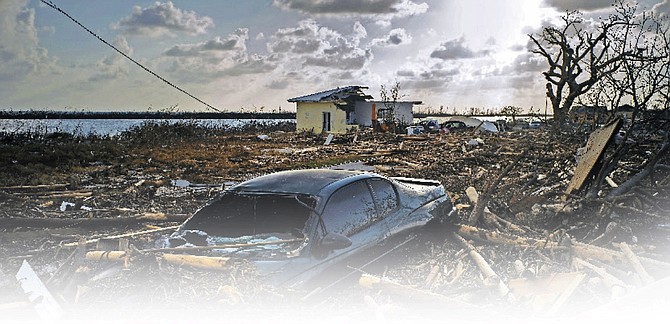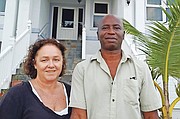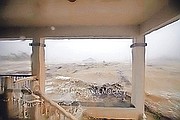By DENISE MAYCOCK
Tribune Freeport Reporter
dmaycock@tribunemedia.net
A YEAR after Hurricane Dorian made landfall in Grand Bahama, the island is still declared as a disaster zone with many residents and businesses picking up the pieces.
The storm made landfall in the country on September 1, 2019, as the strongest storm ever to hit The Bahamas.
Major clean-up efforts are ongoing to rid the island of massive debris and thousands of derelict vehicles destroyed during the storm.
Recovery and rebuilding has been a long and slow process, but some progress has been made due to the outpouring of humanitarian response and assistance by many foreign and local NGOs and through government assistance programmes. The island still does not have full potable water restoration.
Dorian was different from the other storms Grand Bahama had experienced previously. It sat on the island for 40 hours after wreaking havoc on Abaco and the fury and level of devastation unleashed on the island was catastrophic.
At least 31 Grand Bahama residents are listed as dead or missing due to the storm, including several children. It was the largest number of mass casualties ever recorded on the island.
The storm’s official death toll is 74, with the bulk of that figure being Abaco residents, however many more remain missing, leaving families without closure.
Dorian pummeled Grand Bahama with 180mph winds, and gusts of 200mph, and swept 25ft storm surge across 80 percent of the island, and buried communities in tons of debris.
Homes were swept off their foundations; businesses were flooded and left in turmoil; and essential services and infrastructure, as well as schools, and the island’s only hospital and airport were left severely damaged in its wake.
Dave Mackey, and his wife, Cathy, said the memories of the “horrific” day one year ago came flooding back much earlier before Dorian’s anniversary.
“For me, it was when the hurricane season started and the memories came in,” he said. “All of us felt the gloom when the season started and the number of storms had been forecasted. It was, ‘here we go again.’”
During Doria, the water level rose to the second-floor balcony of their canal-front residence in the Pine Bay subdivision.
“I remember the water and how high it was,” Mrs Mackey recalled.
“It was horrifying because we are up to 20ft, and to have the water up there with you - all around was just water,” Mr Mackey added.
According to Mrs Mackey, they are still traumatised.
“We put everything away for the storm (Dorian) and we are afraid to take anything out. We can’t relax. And so much stuff that does not belong in the house has been brought up, and you are constantly reminded of why it is there and in the way.”
Pine Bay, and many of the other water-front subdivisions ‘over the bridge’ in East Grand Bahama, are prone to severe flooding because of the canals. The area has changed dramatically, and a small percentage of residents are now living there.
“Coming out here was like a war movie,” Mr Mackey said.
All of the single-story homes in the area were destroyed. The Mackeys’ house was among the very few that remained intact because it was built some 20ft high on columns - supported by 41 stilts driven eight feet down in the bedrock – able to withstand hurricanes.
To date, about 90 percent of the residences are still not habitable in Pine Bay.
There is a stark difference in the areas ‘over the bridge’ compared to the Lucaya and Freeport areas, where there has been significant progress in the restoration.
Not much progress in restoration has been made there in over a year. Although water and electricity have been restored ‘over the bridge’, there is still no cable television, internet, and telephone services.
There has not been any restoration work of those services in East Grand Bahama, which appears to be neglected due to the loss of so many residential customers in the area.
Another issue is the standing water in swimming pools at many of the derelict homes there that require the urgent attention of the Department of Environmental Health Services to prevent the breeding of mosquitoes, other insects, and rodents.
Dorian also triggered perhaps one of the country’s worst environmental disasters - a catastrophic oil spill at the Equinor South Riding Point plant in East Grand Bahama. About 55,000 barrels (2.3 million gallons) of oil spilled at the oil storage facility, and in the surrounding forest. Major clean up of oil had started but was stalled in March following the Covid-19 pandemic.
East End communities from Freetown to McLean’s Town, and also Sweeting’s Cay there were hardest hit, are still significantly challenged with restoration. Attempts were made to reach Deputy Chief Councillor of Sweeting Cay’s Gladstone Russell, but efforts proved fruitless.
Deputy Prime Minister Peter Turnquest, MP for East Grand Bahama, says it has been hard for the residents in Grand Bahama, particularly in the east.
“Since that day, residents have had it hard trying to put things back in place and reconcile with physical loss and the post-traumatic stress of trying to move on without loved ones. It’s not been an easy year for most. Simple things such as having a job or finding adequate shelter have been a challenge for many,” he said.
“Unfortunately, the government’s resources have been stretched extremely thin by the sheer magnitude of the destruction on both Abaco and Grand Bahama, which has been compounded by the COVID-19 experience,” said Mr Turnquest.
He indicated that the government has tried to do its part within the limitation of its resources, providing temporary rental assistance, food assistance, home repair assistance, and debris removal.
With all that has been done, Mr Turnquest more work is needed including completion of the repairs and upgrades to the Rand Memorial Hospital; completion of the transfer of the airport to the government and a new design and terminal construction; completion of the various economic projects announced and in progress before and since the storm and COVID.
Agreements signed for the sale and redevelopment of the Grand Lucayan Resort and Freeport Harbour by Royal Caribbean Cruise Line and ITM Group, and Carnival port project in East Grand Bahama have been delayed following the devastation caused by Dorian.
Mr Turnquest also noted that repairs to the GB Highway in the east are expected to be started within the next month after several delays due to technical and operational challenges with the asphalt plant.
The rebuilding of the clinics, the government complex, the administrator’s residence, and restoration of the community parks; the building of a new comprehensive school and hurricane shelter in High Rock; and the repairs to the government dock building in McLeans Town, which houses the police station and other public facilities, are underway.
Temporary homes are being relocated to Sweeting’s Cay, and the water supply is being restored. “We hope to have electricity restored before long in both communities,” Mr Turnquest reported.
He also noted that the erection of other temporary homes to help people transition back into these communities is expected. And, the finalisation of crown land grants so that people can rebuild on land they occupied before the storms.
Speaking to the loss of lives, Mr Turnquest described it as an “unimaginable horror and loss.” Despite warnings and urging before the storm, many did not evacuate. He said they continue to pray for those families who lost loved ones.
“Twenty-two persons either did not make it or are still unaccounted for, including persons I would have pleaded with personally to leave the afternoon before. It is still very vivid in my mind those faces and the last conversations as I urged families to evacuate,” he recalled. “They are all gone now, and I often reflect on them, their unique characters. Some were extremely loving and sweet, others very sweet but always ready to debate. Some were just quiet and kind.
“The horror of the aftermath and the anxiety of the search and rescue has lasting impressions. What I saw, I would never want to see again. Unbelievable is the best word to describe what we found. Washed out roads, homes cleaned away to the foundation as if no structure ever existed. Just unbelievable,” he said.
Mr Turnquest stressed that support from NGOs has been tremendous.
He also said the government looks forward to the restoration of communities and the return of residents and businesses.
The more than 200 businesses affected have had access to business recovery grant funding provided by the government and in partnership with the Grand Bahama Port Authority.
Meanwhile, Grand Bahama Chamber of Commerce president Greg Laroda has called for major stakeholders to come together for the development of a “generational” plan for the island’s recovery. He believes that the government, Grand Bahama Port Authority, and the chamber must work together to come up with the best possible plan that will put the island on the right path to recovery.
As Grand Bahama continues to recover from Dorian, a monument constructed at the foot of the Sir Jack Hayward Bridge on July 14 honours the 31 souls lost on September 1, 2019, with the names of all engraved.
The deceased are Catherine Armstrong, Clarissa Collie, Daisy Cartwright, Freeman Carey, Irene Saunders, Kenel Joseph, Latravalia Williams-Daniel, Ango Daniel, and Marvin Rolle. The missing are Aaron Cooper, Adam Cooper, Albert Bridgewater, Clarence Jones, Darnita Cooper, Donluck Munnings, George Laing, Hennilee Mackey, Howard Bevans, J’vonaje Forde, Mateo Bethel, Monique Munnings, Omarion Munnings, Philip Thomas, Philip Thomas Jr, Raphaela Munnings, Remeille Thomas, Roswell Pinder, Shirlene Cooper, Sybil Pinder, Tanae Pinder, and Terrell Lightbourne.
Fifty-five unidentified Dorian victims were buried in Abaco in May.







Comments
Use the comment form below to begin a discussion about this content.
Sign in to comment
Or login with:
OpenID